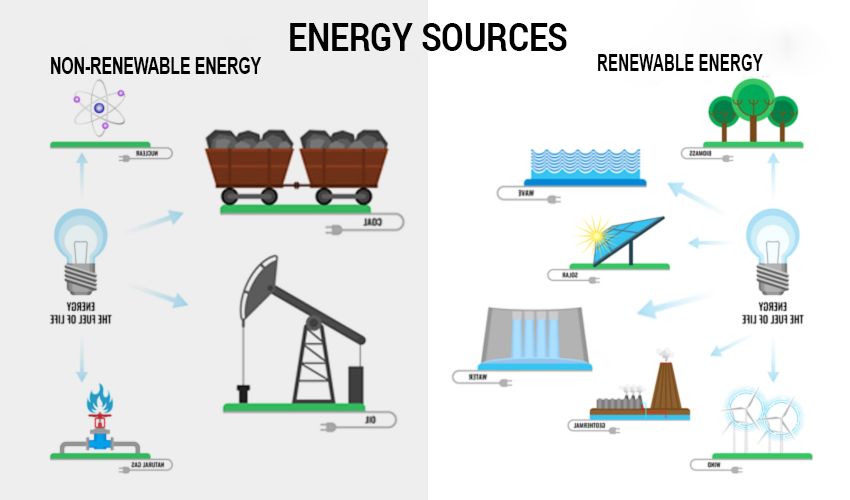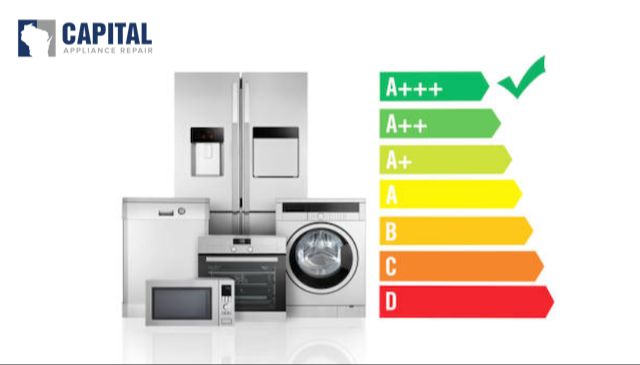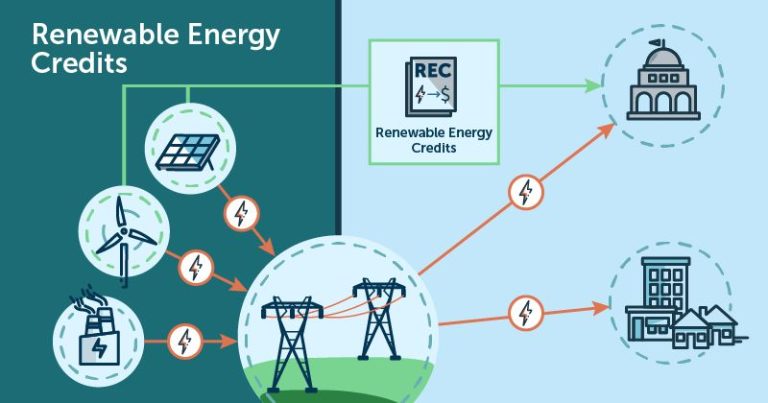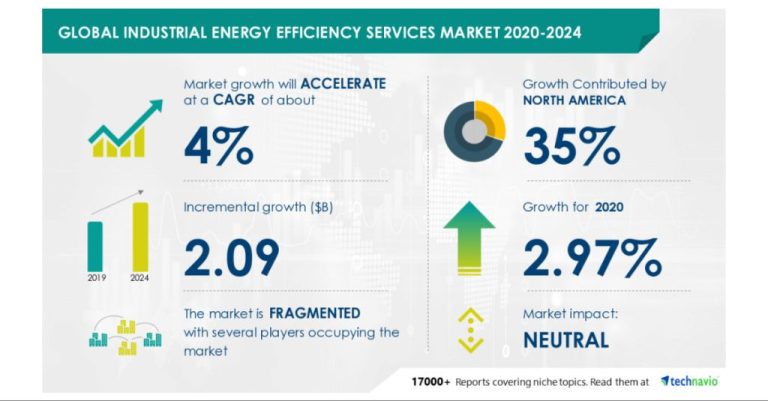What Are Renewable And Non-Renewable Energy?

Renewable energy sources and non-renewable energy sources are the two main classifications of energy sources on Earth. Renewable energy comes from natural sources that are replenished constantly and are practically inexhaustible. This includes energy from the sun, wind, water, plants, and the Earth’s heat (Source). In contrast, non-renewable energy comes from sources that will eventually dwindle in supply and are not replenished in a human timescale. This includes fossil fuels like oil, coal, and natural gas that come from the ground (Source). Understanding the differences between renewable and non-renewable energy is crucial as we work to build a more sustainable future. This article will provide an in-depth look at the pros and cons of both energy sources.
Types of Renewable Energy
Renewable energy comes from natural sources or processes that are constantly replenished. Here are some of the main types of renewable energy technologies and sources:
Solar Energy
Solar power is energy from the sun that is converted into thermal or electrical energy. Solar energy can be captured and converted in a few ways (https://www.nationalgrid.com/stories/energy-explained/what-are-different-types-renewable-energy):
- Photovoltaic (PV) panels directly convert sunlight into electricity.
- Concentrated solar power (CSP) uses mirrors to concentrate sunlight that heats a liquid to drive a steam turbine which generates electricity.
- Solar heating systems capture solar energy as heat for water heating, space heating, and industrial processes.
Wind Energy
Wind power captures the kinetic energy of wind, typically with turbines that generate electricity. Large scale wind farms consist of many individual wind turbines spread over a large area.
Geothermal Energy
Geothermal energy taps heat from under the earth’s surface for electricity generation, heating, and cooling. This can be done by piping hot water or steam from geothermal reservoirs to drive turbines or directly using the hot water/steam for heating applications.
Hydropower
Hydropower harnesses the energy of flowing water – from rivers or man-made reservoirs – to generate electricity using turbines. Hydroelectric dams and pumped-storage hydropower are two common methods.
Biomass
Bioenergy involves burning organic matter – like plants, wood, and waste – as a fuel to produce electricity, provide heat, or make biofuels.
Benefits of Renewable Energy
Renewable energy provides many benefits compared to fossil fuels and nuclear power. Some key benefits include:
Clean and sustainable: Renewable sources like wind, solar, hydroelectric, geothermal and biomass don’t produce air pollutants or greenhouse gases. This makes them a sustainable long-term energy solution that doesn’t damage the environment (source).
Reduces pollution: Using renewable energy sources reduces reliance on fossil fuels like coal and natural gas, which produce pollutants that contribute to smog, acid rain, and health problems. Widespread use of renewables can improve public health by reducing air pollution (source).
Tackles climate change: Renewables produce little to no global warming emissions, which is crucial for slowing climate change. Transitioning to renewable energy is a key strategy for reducing greenhouse gas emissions and mitigating global warming (source).
Challenges of Renewable Energy
Although renewable energy sources provide many benefits, they also come with unique challenges that need to be addressed for their widescale adoption. Three major challenges are intermittency, high upfront costs, and storage issues.
Intermittency refers to the fact that some renewable energy sources, like solar and wind, are not available at all times. The sun doesn’t always shine and the wind doesn’t always blow, so these sources provide energy intermittently. This can make it difficult to integrate them into the existing electric grid infrastructure without suitable storage solutions (https://sustainablereview.com/challenges-in-renewable-energy/).
High upfront capital costs are another barrier for many renewable technologies. Constructing wind farms, solar fields, and other infrastructure is expensive at the outset. Although renewable energy has very low or zero fuel costs once built, overcoming the initial financial investment can be prohibitive without government incentives or policies (https://regenpower.com/what-are-the-problems-faced-by-renewable-energy/).
The variability and unpredictability of some renewables increases the critical need for cost-effective energy storage solutions. Storage helps smooth out supply and allows renewable energy to be dispatched when needed. However, at scale, storage technology remains expensive and presents technical hurdles (https://www.iea.org/reports/renewable-energy-market-update/challenges-and-opportunities-beyond-2021).
Types of Non-Renewable Energy
The main types of non-renewable energy sources are fossil fuels, including oil, coal, and natural gas. Fossil fuels are formed over millions of years from the remains of living organisms and are considered non-renewable because their rate of formation is extremely slow.
Oil, also known as petroleum, is a liquid fossil fuel that is found underground and offshore and is used to make gasoline, diesel, and many other products. Coal is a solid fossil fuel that is mined from the earth and is used mainly to generate electricity. Natural gas is a gaseous fossil fuel that is found with oil deposits and is used for heating, cooking, and electricity generation.
Other non-renewable energy sources include nuclear power, which relies on uranium that must be mined, and mined materials like sand and metals that are used to make solar panels, wind turbines, and other renewable energy technologies. While renewable energy can be replenished, sources like fossil fuels and nuclear fuel cannot be easily replenished and will eventually run out if not used sustainably.
(Energy Kids,
National Geographic)
Drawbacks of Non-Renewable Energy
Non-renewable energy sources like coal, oil, and natural gas have some major drawbacks. Most significantly, they are major contributors to air and water pollution and climate change. Burning fossil fuels releases greenhouse gases like carbon dioxide and methane into the atmosphere, trapping heat and causing the planet to warm over time [1].
Fossil fuel extraction and use also leads to high emissions of sulfur dioxide, particulate matter, and nitrogen oxides – air pollutants that have been linked to acid rain as well as respiratory illnesses. Coal mining and oil drilling can also contaminate groundwater and soils. Overall, fossil fuels are dirty energy sources that have many harmful environmental and public health consequences.
Another critical drawback of non-renewables is that they are finite resources that will eventually run out. Coal, oil and natural gas deposits took millions of years to form, and once depleted they are gone for good. Relying largely on non-renewables is ultimately unsustainable, as supplies will dwindle and demand will continue to grow with population and development. The world needs to transition to clean, renewable energy sources that can provide power indefinitely without fuel shortages.
Global Usage of Renewable vs Non-Renewable Energy
Currently, about 85% of the world’s energy comes from non-renewable sources like oil, natural gas, and coal, while only around 15% comes from renewable sources like wind, solar, hydroelectric, and biomass (Source). The percentage of renewable energy usage is growing, however. According to the International Energy Agency (IEA), renewable electricity generation grew over 8% in 2021 to reach 8,300 TWh, representing the fastest year-over-year growth since the 1970s (Source). Globally, renewables made up 29% of electricity generation in 2020, with hydropower accounting for 16.8% (Source). While non-renewable sources still dominate energy production worldwide, adoption of renewable energy is rapidly increasing.
Transition to Renewable Energy
Transitioning to renewable energy sources is a critical goal as countries seek to reduce carbon emissions and mitigate climate change. Many governments have implemented policies and initiatives to increase the share of renewables in their energy mix. According to the UN, renewable energy could provide 65% of total global electricity supply by 2030 if there is sufficient investment and supportive policies [1]. Some key goals and efforts to transition to renewable energy include:
– The Paris Agreement’s goal of limiting global warming to 1.5°C or 2°C above pre-industrial levels will require rapid decarbonization of the energy sector through renewables. Countries have set targets to increase renewable capacity through their Nationally Determined Contributions (NDCs).
– The EU aims to have 32% of its energy from renewables by 2030 under the Renewable Energy Directive. All member states have adopted national renewable energy action plans including targets and policies.
– China plans to have renewable energy account for 50% of total electricity generation capacity by 2030. This is up from 29% in 2018. China has provided large subsidies for solar and wind energy deployment.
– Corporate renewable energy purchasing by companies like Google, Apple, and Amazon has driven utility-scale solar and wind capacity additions in the US. Over 200 global companies have joined the RE100 initiative to go 100% renewable.
– At the city level, the C40 Cities network has 76 member cities committed to implementing climate action plans and transitioning to clean energy.
Rapid technology cost reductions, policy support, private sector action, and public pressure for climate change mitigation are driving the transition away from fossil fuels and toward renewable energy adoption worldwide.
The Future of Energy
The future looks bright for renewable energy. According to the UN, renewables are projected to supply up to 85% of global electricity by 2050.1 The US Department of Interior notes that renewables will continue rapid growth as costs decline and new technologies emerge.2 The New York Times reports that wind and solar power are breaking records, and renewables will likely overtake coal globally by 2025.3
Some key emerging renewable technologies to watch include floating offshore wind farms, solar roads and windows, enhanced geothermal systems, and wave/tidal power. Continued innovation and falling costs will enable renewables to play a major role in the future global energy mix.
Conclusion
In summary, renewable energy comes from natural sources that are constantly replenished, such as sunlight, wind, water, plants, and geothermal heat. Renewable energy provides clean power without harmful greenhouse gas emissions and has the potential to supply the world’s energy needs in a sustainable manner.
Non-renewable energy comes from finite resources like coal, oil, and natural gas. While inexpensive and reliable in the short-term, non-renewables contribute heavily to climate change and air pollution. As supplies continue to dwindle, non-renewables are becoming increasingly expensive to extract.
There is an urgent need for the world to transition from fossil fuels to renewable energy in order to combat climate change and build a sustainable future. Renewable energy already supplies over a quarter of the world’s electricity, and capacity is growing rapidly each year. With appropriate policies, investments, and public engagement, renewable energy can reliably and affordably replace fossil fuels across the globe.
The renewable energy transition provides tremendous opportunities for economic growth, job creation, and improved public health. But it requires both personal and collective action. Individuals can make a difference through their choices as consumers and voters. By working together and embracing the shift to clean energy, we can overcome the climate crisis while building prosperity for current and future generations.






